Windmöller and Hölscher’s Easy Check module monitors for colour issues during a print run
There’s a lot of work involved in setting up a flexo press, but automation is increasingly taking care of most of this. By Nessan Cleary.
We all know that flexo printing is facing a number of challenges, from the trend toward shorter runs to the ongoing need to cut costs. The obvious answer is to add more automation to the presses to speed up makereadies and reduce waste. Better still, automation should also remove inconsistencies throughout the press run to produce better print results. But such automation comes at a price, so most vendors offer optional modules that allow converters to tailor their presses to their own budgets.
Alan Attard, managing director at Eurograv, pointed out that most flexo presses already have a high degree of automation, noting, ‘All the adjustments are done by servo motors so there is a high level of automation to start with.’
There is an obvious trade-off between increasing the cost and the added value of any automated modules. So most vendors have concentrated on three main areas; reducing both the time and waste associated with job changeovers as well as improving the performance of the press. These are mainly achieved through automated impression and registration settings.
Ready to go
Eurograv is the UK agent for Uteco, which has developed the Kiss&Go automatic impression setting system that reads the actual image being printed directly after the exit of the CI and selects the best image for impression within just a few impressions. Mr Attard said that this is now installed on 90% of all presses sold.
Uteco also sells two further options developed with Grafikontrol. Thus K-register puts the job into register during the Kiss&Go phase reading micro marks, while Chroma Lab is an inline spectrophotometer. Mr Attard revealed that Uteco will be demonstrating its colour control options more fully at drupa.
KBA Flexotecnica has also developed modules covering similar areas. Thus UK sales manager Richard Warnick explained that the company has a semi-automatic approach to registration, saying, ‘We work with suppliers of inspection equipment and make a dynamic link to the printing press.’ These suppliers include BST eltromat, Grafikontrol and QuadTech. He added, ‘We’re working with BST eltromat on a method to automate the way we find the position to register the machine. It is not a big deal, but there is about 5 to 10 metres of waste and it should make things a bit more convenient.’
Another module is the Automatic Impression by Flexotecnica (or AIF), developed in house, which can work without dedicated marks. Mr Warnick said, ‘We run the press at very low speed and all the used print units rotate while the measurements are made but without printing.’ This uses up to 35 metres for a complete impression.
Making it easy
Windmöller & Hölscher has a number of Easy-branded modules that can be added to its presses so that converters can choose the degree of automation they need. This includes the automatic impression setting system Easy-Set S, which is fitted as standard. But Tom Wiltshire, director of W&H’s UK agent Wantzen, said that nearly all customers choose to upgrade this to Easy-Set HD, which leads to better images.
Mr Wiltshire explained that many customers also opt for Easy-Reg D, which takes information from a camera system to automate registration and complements Easy-Set HD. There is an alternative in Easy-Reg S, which uses register marks applied to the sleeves.
W&H also has several options for automating colour control, including Easy-Col for automatically matching ink formulations. Another option, Easy-Check, uses an inline sensor to monitor the press as it runs. Mr Wiltshire explained, ‘Easy-Check is looking at the running colours, the spot colours and the density of the process colours and the dot gain, and if anything has changed during the run from the standard then it sets an alert for the operator.’
Soma offers the Falcon option for automatic impression settings without the need for print marks. Anton Mitchell, sales manager for Soma’s UK agents Engelmann & Buckham, said that although it is an optional extra, most customers include it as standard, and added, ‘Most also opt for automatic wash-up systems.’
The company also supplies an ink cartridge system, which effectively automates the ink handling and reduces the amount of ink that needs to be loaded. This is particularly useful for short run jobs and special effects.
Mr Mitchell said that a lot of customers are also looking at 100% web inspection systems that can record where there is a defect within the roll and map it so that it can be dealt with later.
Savings made
Comexi brands its automation modules under the Cingular name, and includes options for automatic setting of registration and impression. It has collaborated with AVT for its Cingular Real press control, which automatically sets the pressure for each printing deck by analysing the printed image pressure as well as the registration of the press through comparison with a PDF file.
The latest version of this, Cingular Real2, is said to improve the makeready process by optimising the communication between AVT’s Argos E Turbo system and the press. The system was installed last year at Clondalkin’s Flexoplast factory in Holland. Clondalkin found that it was saving two minutes plus around 150 metres of material for each makeready, a significant saving given that this factory would typically see 10 to 15 makereadies per day.
The AVT Argos E Turbo system is a 100% inspection system that is said to work with any substrate and at high speeds. It can detect various defects from colour variations and mis-registration through to spots and doctor blade streaks. Further options for it include the ability to include verification and colour measurement.
AVT offers a large number of options for automating various aspects of printing. This includes the flagship Argos Turbo system, a fully automatic quality assurance and process control system, which uses one camera to inspect the whole web all of the time, and a second camera to zoom in on specific areas, all at high speed. But AVT also sells its own systems for automatic and semi-automatic register control, as well as for automatic pressure control, with versions for CI presses and for narrow web presses.
More control
Italian company Grafikontrol has collaborated with a number of the press vendors, but also has several options of its own. This includes Chromalab, which is capable of inline reading of colour Delta E, Lab and density values and generally monitoring colour throughout the job to give comparisons against master values. There is also Grafikontrol Lynex, for 100% defect detection, with full reporting of roll defects. It marks the web with a code describing the defects it detects. It can display the image of the full repeat on a web width-size, UHD monitor, which more or less replicates the effect of looking at the actual print.
Another option, Grafikontrol Procheck, takes the data gathered from the marks that the Lynex module puts on the web and sends this to a downstream operation such as a slitter where the codes are picked up, the slitter stopped and the defect removed.
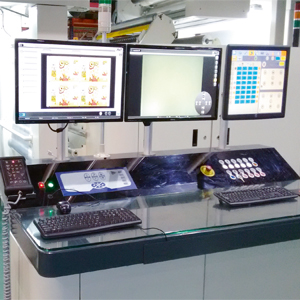
Comexi has updated its Cingular Real automation option with improved communication between AVT’s Argos E Turbo system and the press
Tresu has developed a system for automatic ink control. The heart of its approach is the F10 iCon ink supply system, which regulates ink flow, pressure and viscosity for a constant, accurate ink density on the printed substrate without the risk of air contamination.
The company is working with some manufacturers, such as Bielloni, to fit the system as standard, but it can also be retrofitted to most other wide web flexo presses, both for CI and inline designs, with either solvent or water-based inks, but not UV inks. It is a closed system that reduces the waste of ink and cleaning time and evaporation from solvents.
It can be integrated to existing press control systems or used standalone without any connection to the existing system. The system knows how much ink has been used and can automatically refill the ink. In addition, it can also automatically clean all the ink units at once and is capable of achieving a complete ink change cycle in five to ten minutes.
Conclusion
For the most part, automated impression and registration settings are specified with most new presses, along with things like automatic wash-up as converters look to maximise job changeovers. However, although all of the press manufacturers now offer options for ink controls and matching colours during a press run, most admit that these are harder to sell. But inevitably, as converters look to squeeze the maximum efficiency out of their presses, and the cost of these options reduces so we will see more of these being installed.
There does seem to be growing demand for 100% inspection systems with most press vendors partnering with specialists such as AVT and BST to satisfy this. We’re likely to hear more about this at the upcoming drupa show. But increasingly, some of these automation options are now being designed into new wide web presses, which makes it easier to integrate them directly into the press control systems.

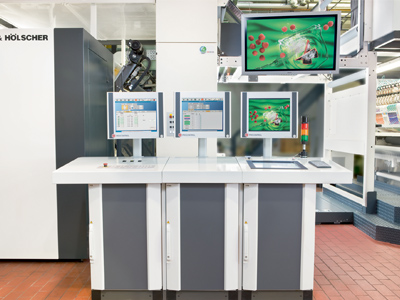
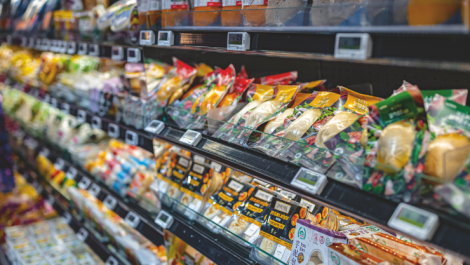
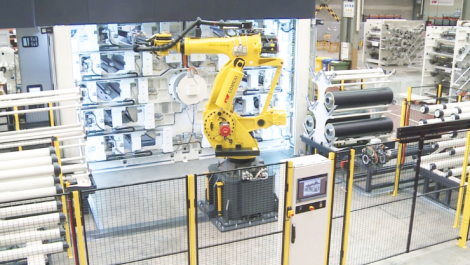
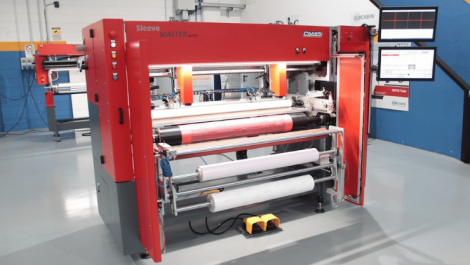
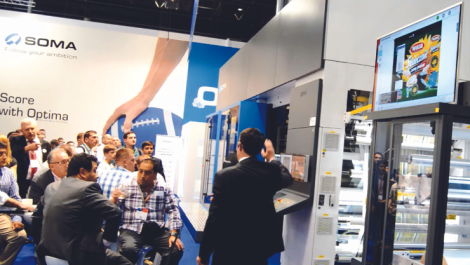

The company I work for has a kba flexo press/ CI drummed. Its 6 years old n register system is in need of help. Hangs up on moves n Camera system is ok at best. Is there anywhere a upgrade out there?